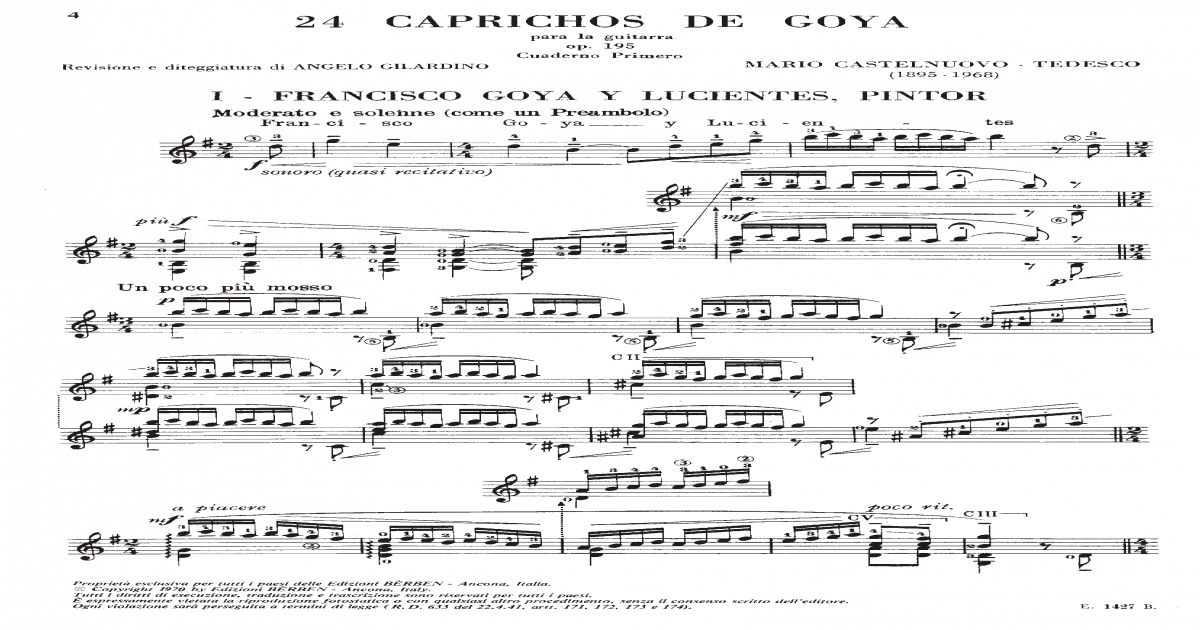


We may not hear the monsters in the music, but the set of five variations puts us inside the tormented man’s head, as each new variation takes the same old theme and brings it around again and again and again.Ĭastelnuovo-Tedesco’s picture of Goya’s world through the medium of the guitar made use of an inspired choice of instrument. El sueno de la razon produce monstruos (The sleep of reason produces monsters) (Zoran Dukić, guitar) The piece ends slowly and solemnly.Ĭastelnuovo-Tedesco: 24 Caprichos de Goya, Op. is performed ‘con fuoco’ (with fire), exploring the theme in slower notes. 4 gives us the chaconne melody in the treble again before the last Var. III put the chaconne in the base with upper voice scales. Goya: Capricho № 43: El sueño de la razón produce monstruos (The sleep of reason produces monsters)The music takes this on a variation set. A sleeping man is surrounded by the things of nightmares: evil owls, a lynx, and many shadowy bat-like creatures.
Castelnuovo tedesco caprichos de goya pdf series#
One of the most famous images from the series might actually be a self-portrait of Goya. ¿Si sabra mas el discipulo? (Perhaps the pupil knows better?) (Zoran Dukić, guitar). In addition to the Gavottes, two Musettes are added, mocking modern dissonance.Ĭastelnuovo-Tedesco: 24 Caprichos de Goya, Op. He starts with a twelve-tone construction in the style of the Second Viennese School before converting it all into a non-Schoenbergian Gavotte, then going on to write musical inversions and retrogrades in the 12-tone style. Goya’s sarcastic and biting commentary on education takes the form of a teacher and a student, but it is the student who is teaching his master the alphabet and both are donkeys.Ĭastelnuovo-Tedesco takes on modern music theory after a bit of braying. El amor y la muerte (Love and death) (Zoran Dukić, guitar) The final bars represent the dying convulsions of the mortally wounded man…Ĭastelnuovo-Tedesco: 24 Caprichos de Goya, Op. You can even imagine you can hear the duel going back and forth. Goya: Capricho № 37: ¿Si sabrá más el discipulo? (Perhaps the pupil knows better?)In his Tempo di Tango, the music is made of two contrasting elements: rhythmic chords (the false bravery of the duelist) and a plaintive, descending these (the grief of the woman). The first caprice is a portrait of the painter, shown as authoritative, well-dressed, and debonair. Despite the seriousness of his criticism, his informal artistic style in the pictures keeps the set from being overly severe and foreshadows the modernist movement of a century later. He rails against superstition, the ignorance and inabilities of the various members of the ruling class, the actions of the clergy, pedagogical short-comings, marital mistakes and the decline of rationality. Goya used the images to condemn contemporary Spanish society by laying bare its follies and foolishness. The light-hearted title, Los Caprichos (The Caprices) is contradicted by the dark imagery. Los Caprichos (The Caprices) were created in 17 and published in 1799. Of the 80 images in the Los Caprichos set, Castelnuovo-Tedesco set music to 23 of them. Other engravings by Goya from his series Los Caprichos were similarly influential on the Italian composer Mario Castelnuovo-Tedesco (1895-1968) to write a set of pieces for the guitar entitled 24 Caprichos de Goya, Op. Goya: Capricho № 1: Francisco Goya y Lucientes, pintor (Francisco Goya y Lucientes, painter)We looked earlier at the Spanish artist Francisco Goya (1746 – 1828) and how his ‘maja’ pictures influenced the 20th century Spanish composer Enrique Granados (1867-1916) to create his Goyescas.


 0 kommentar(er)
0 kommentar(er)
